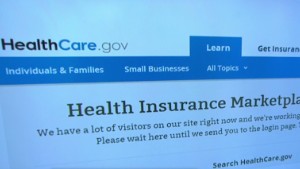Editor's note: Aaron E. Carroll is a professor of pediatrics at the Indiana University School of Medicine and the director of its Center for Health Policy and Professionalism Research. He has supported a single-payer health system during the reform debate. He blogs about health policy at The Incidental Economist and tweets at @aaronecarroll.
(CNN) -- The rollout of the federal Obamacare website has been a disaster, full stop. There can be no excuses, nor will I be making any. It's been clear for years what needed to be done, and failing was not an option. The exchanges, and the website that allowed access to them, had to work, and they just do not.
I wrote a week or two ago that the initial problems with the HealthCare.gov website appeared to be because of volume issues. That could be spun as either a positive or negative thing. But it now seems that the surge was not the cause of the malfunctions. After the first weekend, when the administration added additional capacity to the servers, the issues didn't go away.
What are they? I wish I could say for sure. But some good reports have come out that detail just a few of the problems.
The first appears to be that the administration decided that people would need to provide a significant amount of personal detail to look at coverage options. I can attest to this first-hand. I have insurance through my work, so I don't need exchange coverage, but I was still interested in looking at what was available.
 Aaron Carroll
Aaron Carroll I had to provide a lot of information, about my job and family, before I could do so. It's possible that this was because administrators wanted to be able to provide subsidy information to people with the premium costs, so as to soften the blow of how expensive insurance could be, but no one knows for sure. Regardless, this complicated things significantly.
But that's just the front end. The back end is also a real problem.
Insurance companies are reporting that the data they are receiving from the HealthCare.gov website is garbled. This means that automatic processing of the insurance plans being ordered is impossible.
Oddly enough, the problems on the front end are actually helping here. So few orders are actually making it through that insurance companies are able to sort through the bad data by hand to complete enrollment. But if things improve on the front end, then there's no way these companies can do millions of applications without good data.
The administration is bragging that upwards of half a million applications have started. Shockingly few of them have been completed, though.
The front end has a number of steps, including submitting your information, assessing for eligibility and then shopping for insurance. The number being cited by the administration refers only to people who have completed the first step.
 Obama: No sugarcoating website issues
Obama: No sugarcoating website issues  Obama details website workarounds
Obama details website workarounds  Issues plague Obamacare exchanges
Issues plague Obamacare exchanges There are people who believe that government can never do things as well as the private sector. I'm not one of those people. But in this specific instance, those people have a point.
Evidently, those in charge of the rollout of the exchange website were unprepared. They didn't have the necessary experience to manage the more than 50 different contractors producing software independently that would eventually need to function together as a whole. This is incredibly technical work, and it's not clear that government was in a good position to direct things here.
It appears that the Obama administration has learned its lesson.
Administration officials are now calling in "more computer experts" to try and fix the problem. But this may be too little, too late. Some are saying that even if the administration pours in massive resources, the problems may not be fixed by December 15, the deadline for when insurance needs to be bought for it to be covering people on January 1.
Even if the administration can get this done within a month, some in the insurance industry are concerned that these issues may act as a filter to dissuade healthy people from getting insurance. If it's really, really hard to complete an application, then only truly ill people may have the perseverance to do so.
That could lead to problems in the pool of people signing up for insurance. The administration needs healthy people to buy insurance, too, for the exchanges to function optimally
If we were talking about a company having mismanaged things so badly, you could be sure that heads would roll. Many would be fired, and there would be a change in management. But that may not be possible here.
Were Health and Human Services Secretary Kathleen Sebelius to go, President Barack Obama couldn't get someone else vetted and through the Senate nomination process in an expedient manner. He's likely stuck with his current team, or no team at all.
That doesn't mean Obamacare will fail. It's still possible that this could all be fixed. It's also possible that should significant issues continue, timelines might be adjusted to accommodate implementation issues. But these will cause problems political and real in nature.
Continued failures in the exchange rollout give the President's opponents fuel to attack him and his health care reform. More importantly, they prevent people who really do need insurance, and the care it allows, from getting what they need.
Follow us on Twitter @CNNOpinion.
Join us on Facebook/CNNOpinion.
{ 0 comments... read them below or add one }
Post a Comment